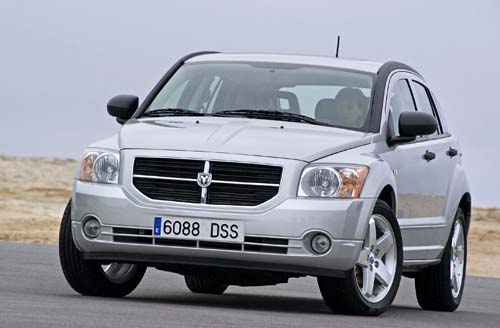2007 Dodge Caliber
The first thing you need to know is the all-new 2007 Dodge Caliber is a compact car. I point this out because many don’t see it that way. I know I didn’t – the Caliber actually has a significantly taller roofline than the pretty serious-looking Dodge Magnum it’s parked next to. True, the track is somewhat narrower than the Magnum, but the fact it comes close to a full-sized station wagon speaks to the roominess at play.
Chrysler, in fact the entire domestic auto industry, has long been in need of a serious competitor in the compact car category. The Japanese imports gained an early foot hold in this segment and have expanded from this base to challenge (and, some would say dominate) other markets traditionally seen as European or Domestic strongholds.
The Caliber represents a radical departure from the vehicle it is replaces – the Neon-based Dodge 2.0 SX. From the sheet metal on through to the powertrain the Caliber shares hardly a nut or bolt.
A new engine developed in conjunction with Hyundai – the “World Engine” in Chrysler’s lingo – powers the Caliber. The base unit is a 148 horsepower, 1.8L, inline four-cylinder engine. An optional 2.0L four-banger, which produces amore useful 158 hp, is available on the SE and SXT models. The engine of choice, however, is the 2.4L engine in R/T model. With 172 hp, it makes better use of the all-wheel-drive platform. The turbocharged SRT4 should come along later this model year.
Chrysler’s second-generation continuously variable transmission (CVT) is mated to the various engines in an attempt to improve fuel economy. The test vehicle arrived equipped with the 2.0L engine and CVT transmission. A week with it proved the combination surprisingly good on fuel. Getting more than 500 km from the Caliber’s 51-litre tank puts it between its official rating of 9.0 L/100 km City and 7.3 L/100 km Highway.
The exterior styling is difficult to describe. The truth is it looks more like a hybrid blend of truck and hatchback than it is a traditional compact car. The grille is all Dodge Ram pickup, with the rest of the body looking like a miniature Dodge Durango. The blacked-out roof rails exaggerate the curved roofline, which helps to soften the two-box design.
Inside, the Caliber’s finish materials surprise at first – aside from the seats and carpeting the cabin is filled with quite a few hard plastic surfaces. Normally, you tend to find some padded vinyl or a splash of fake wood here and there, not so with Caliber. The result is a somewhat stark finish. Another notable omission is the lack of vanity mirror lighting.
Gripes aside, a few days in the drivers seat (and after listening to a number of passengers) the tactile feel of the interior did not seem so stark. Likewise, the colour contrasting centre console earned its share of compliments from the younger occupants.
There are some nice touches to be found – the illuminated cup-holders and a beverage cooler/rack in the glove box. The test car also came equipped with the nine-speaker Boston Acoustics sound system complete with flip down speakers in the liftgate – it’s designed to turn the Caliber into party-central when parked. Personally, I never found use for this feature.
The Caliber’s interior utility is impressive. The fold-flat front passenger seat and split/folding rear seat backs brings plenty of flexibility that underscores the handy nature of the hatchback body. This also means that, with all the seats down, the Caliber will carry an eight-foot ladder inside, and with the tailgate closed.
On road, the2.0L engine’s smoothness surprises, a big part of which is down to the CVT. It appears to have been programmed to give extra oomph off the line, which adds to the perception of power. However, in the all-important mid-range (accelerating from 60 to 100 km/h), the package takes on a buzzy-go-nowhere-fast characteristic, as it takes a few seconds for the engine and transmission to get it all together. Once up to highway speeds, the Caliber is willing to pull well beyond the speed limit and is a match for most other cars on the road. Perhaps the most impressive engine characteristic is that it does not bog down every time the air conditioning kicks in, which is more than I can say for some other cars equipped with larger engines.
From a safety standpoint the Caliber impresses with standard driver and passenger multi-stage airbags, drivers side inflatable knee bolster airbag and drop-down side curtains. The lone complaint is that the safety of anti-lock brakes remains a $600 option on vehicles not equipped with the CVT2 transmission. This runs contrary to most vehicles in this class but allows DaimlerChrysler to bring the vehicle in at a lower price point.
The entry-level Caliber SE will set you back a surprisingly low $15,995, the mid-range SXT starts at $17,695 while the range-topping R/T lists for $23,995.
Copyright © Auto Reviews Online 2016 | Privacy & Terms of Use | info@autoreviewsonline.com | Website by Brolly Media

